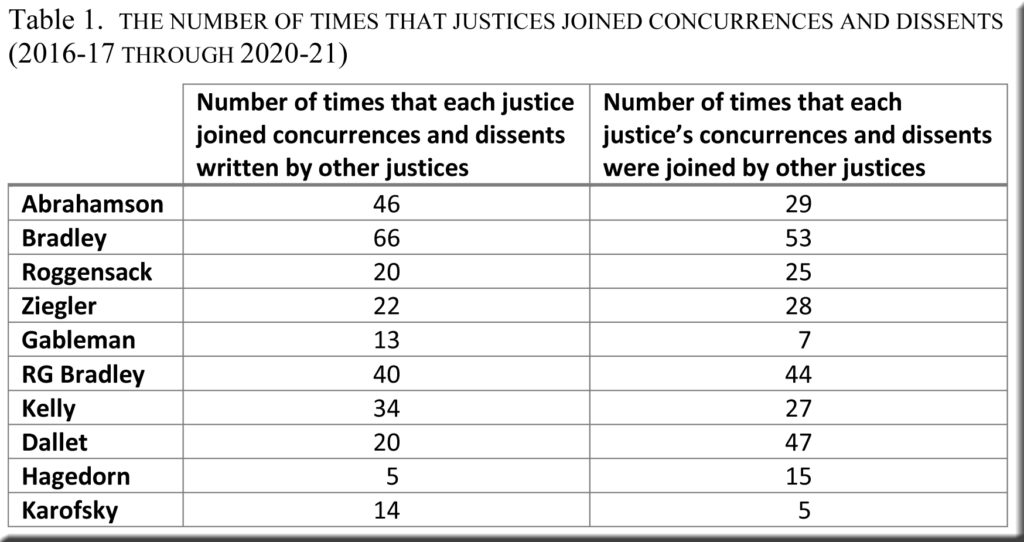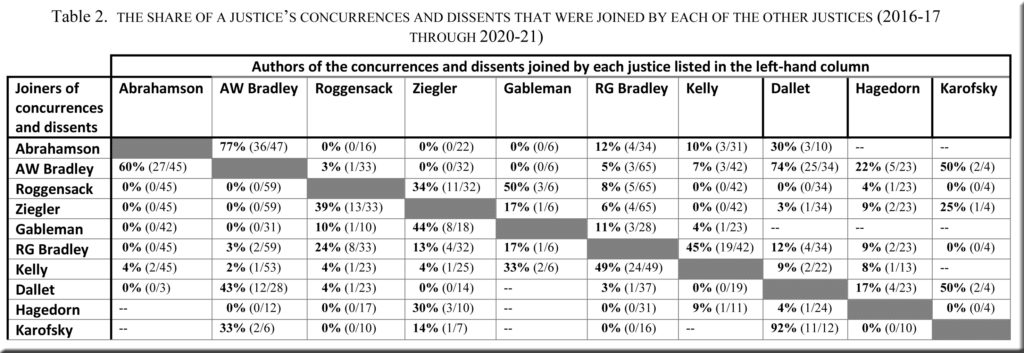Several years ago, a post showcased the varying frequency with which justices joined the concurrences and dissents written by each of their colleagues over a period of seven terms (2008-09 through 2013-14). During that entire interval the court experienced no turnover at all, but its lineup has altered markedly since then, thereby inviting us to revisit the topic of the original post. Although certain themes remain as clear as before, they have been joined by some intriguing developments.
For an overview consider Table 1, which covers the five terms from 2016-17 through 2020-21.[1] The first column shows how many times the justice in each row joined concurrences and dissents written by the other justices, and the second column indicates the number of times that each justice’s separate opinions were joined by the rest of the court’s members. Justice Dallet, for instance, joined her colleagues’ separate opinions 20 times, and they joined hers 47 times.
Misleading impressions can arise from the fact that several justices did not serve for all five terms.[2] For example, Justices Karofsky and RG Bradley each joined two of Justice AW Bradley’s separate opinions in these years, which might suggest a coincidence of views. However, Justice Karofsky arrived on the court only in 2020-21, during which she joined two of Justice AW Bradley’s six separate opinions. In contrast, Justices AW Bradley and RG Bradley both served for all five terms covered by the table—a period in which Justice AW Bradley wrote 59 separate opinions. Thus, while Justices Karofsky and RG Bradley each joined Justice AW Bradley twice, the rate for Justice Karofsky was 33% (2/6) but only 3% (2/59) for Justice RG Bradley.
Table 2 displays corresponding adjustments for all of the justices. A row specifies how many times a justice joined concurrences and dissents written by each of his/her colleagues over the years when both were serving, while a column shows how often a justice’s own separate opinions were joined by others. In Justice AW Bradley’s row, for instance, we learn that she joined 27 of the 45 separate opinions that Justice Abrahamson wrote between 2016-17 and her retirement two years later, while Justice Ziegler’s column informs us that Justice Gableman joined eight of her 18 separate opinions in 2016-17 and 2017-18, before he left the court.
CLICK ON THE TABLE TO ENLARGE IT
Much in the table tallies with prevailing views of the justices as “liberals” or “conservatives,” with members of one group joining each other’s separate opinions regularly, while finding little to tempt them in concurrences and dissents written by justices in the other camp. Few could be astonished to discover, say, that Justice Abrahamson joined 77% of Justice AW Bradley’s numerous separate opinions—or that Justices Roggensack, Ziegler, and Gableman never did in these years. Although the figures may be skewed for pairs of justices whose periods of service barely overlapped, they generally underscore the predictable conclusion that “liberals join liberals,” and “conservatives join conservatives.”
That said, the table also contains entries that fit less comfortably into the ideological framework noted above, especially in the case of Justice Hagedorn. While he stands more often than not with the stauncher conservatives, he has sided with the liberals—and they with him—on a number of occasions. This may be glimpsed in the column for Justice Hagedorn in Table 2, which shows Justices AW Bradley and Dallet joining his separate opinions more frequently than did any of the conservatives.
Although this is interesting, it does not come as a complete surprise in light of a previous post that portrayed Justice Hagedorn as the closest thing to a “swing vote” on the court. But eyebrows may be raised by the data for Justice Kelly, whose voting record placed him routinely amid the court’s other conservatives, including Justices Roggensack and Ziegler. Indeed, during the years covered by the table, he lined up with Justice Roggensack (both in the majority or both dissenting) 81% of the time, and he did so with Justice Ziegler in 83% of the cases where both participated. So, how should we explain Justice Kelly’s column in Table 2, which reveals that neither Justice Roggensack nor Justice Ziegler joined a single one of his many (42) concurrences and dissents? Whatever the explanation, it may not be solely “ideological,” and I would be grateful to benefit from any hypotheses that readers can offer.
[1] The table is derived from cases included in the SCOWstats annual reports—except for Nancy Bartlett v. Tony Evers (2019AP1376), which I omitted because it was so fragmented as to defy confident categorization.
Occasionally, a justice joined only a portion of another justice’s concurrence or dissent. For this post, such instances are counted as joining the opinion.
[2] Justices AW Bradley, Roggensack, Ziegler, and RG Bradley each served all five terms, while the other justices in the table served as follows: Justice Kelly (four terms), Justices Abrahamson and Dallet (three terms), Justices Gableman and Hagedorn (two terms), and Justice Karofsky (one term).


Speak Your Mind